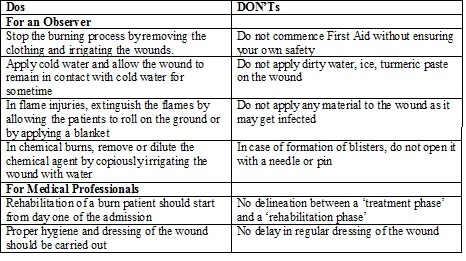Gender Violence:The Health Impact – Immediate Medical Care for Burn Victims
November 28, 2014 Leave a comment
by Rishabh Raj
A report by Acid Survivor Trust International (ASTI) aptly says “acid violence rarely kills … [it] always destroys lives.” The very gruesome nature of the violence coupled with the fact that an acid attack takes only five seconds to cause superficial burn and thirty seconds to escalate into deep burns and that India also accounts for a major share of global burn deaths makes it extremely important to discuss immediate medical care available to burn victims.
Acid attacks inevitably lead to excruciating physical ordeals for the survivors. Upon contact, the acid melts through flesh, muscle, and even bone, until thoroughly washed. Eighty percent of these attacks are directed at women and between 40 per cent and 70 per cent of them target women less than 18 years of age[1].
But acid attacks are not the only form of gendered violence that causes burn injuries. In India, several women are burned alive by their partners, or other close relatives. According to a report by Acid Survivors Foundation of India, this is the most common form of dowry deaths.[2]
In India, about 700,000 to 800,000 people per year sustain significant burns, though very few are looked after in specialist burn units. The highest rates occur in women aged 16-35 years of age[3]. Compare this to the US where annually 500,000 cases receive burn treatment with an average of about 3,300 deaths[4].
Need for appropriate medical care
The medical care available immediately after such an incident is crucial in determining the extent of damage and loss. Hence, it becomes extremely important to understand the complexities of burn injuries and rehabilitation. The most common cause of death for burn patients is infection. The burn skin is very sensitive and can be very easily infected if not taken care and cleaned properly. Hence throughout the course of treatment, strict hygiene measures have to be followed until the wounds are completely healed.
Hospitals not properly equipped
Women who are unable to access proper medical care after the attack could die. Unfortunately, hospitals in India are ill-equipped to handle such complexities. Many hospitals have no facilities to handle acid violence and burn emergencies. Some doctors are not even aware of basic first aid measures such as flushing acid out of the body immediately after the attack. The number of trained burn and plastic surgeons is less than 1100 for more than 1200 million population of India.[5] The situation becomes further grim due to the absence of organized burn care at primary and secondary health care levels, where a woman is most likely to first go after such an incident.[6]
No defined protocol for treating burn victims
In 1998, India was the only country in the world where fire (burns) was classified among the 15 leading causes of death[7]. There is no defined protocol in India for immediate medical attention to burn victims. Burn management remains a relatively new concept here. The concept of legal rights of a burn survivor and the family is also slowly emerging in India.
Under the 11th Five Year Plan, a new initiative was rolled out at the national level to leverage available resources for more effective and standardized delivery of treatment for burn victims. The National Programme for Prevention of Burn Injuries (NPPBI) was started with a goal to ensure capacity building of infrastructure and manpower at all levels of health care delivery system in order to reduce incidence, provide timely and adequate treatment to burn patients to reduce mortality, complications and provide effective rehabilitation to the survivors.
This pilot project was converted into a full-fledged national programme under the 12th Five-Year Plan providing burn management facilities in 67 State Government Medical Colleges at a cost of Rs. 407.21 crore.[8]
It is important to recognize that there is a difference between an accidental burn injury and an acid/dowry burn attack and the approach to medical care has to be based on these factors. While it may be easy for an accidental burn victim to access a health care facility, a victim of acid attack faces intense emotional and psychological fears which hinders the treatment at all the stages.
Finally, burn rehabilitation is an extremely difficult and time-consuming effort. Women have to cope with enormous physical pain and deal, at the same time, with low self-esteem and lack of motivation due to their altered looks and social rejection. Medical care available to the victim in the aftermath of an incident can play a crucial role in minimizing the extent of the loss and needs to be accelerated by the Government as well as the medical professionals in the field with due diligence.
WHO has issued guidelines on burn management broadly outlining the first-aid and a set of checks to estimate the severity of burn. The table below provides a list of Dos and Don’ts for providing immediate relief to a victim.
[1] Trauma Informed Care, Sourcebook, Acid Survivors Foundation India
[2] http://www.asfi.in/upload/media/SOURCE_BOOK_12_feb.pdf
[3] Burns in developing world and burn disasters – Rajeev B Ahuja
[4] Chapter 4: Prevention of Burn Injuries – Total Burn Care
[5] Arun Goel and Prabhat Srivastav, Post-burn Scars and Scar Contractures, Indian Journal of Plastic Surgery, Medknow Publications, September 2010
[6] National Programme for prevention of burn injuries – JL Gupta, LK Makhija, SP Bajaj – Department of Burns, Safdarjung Hospital, Dr RML Hospital, New Delhi
[7] Burn Mortality : recent trends and socio cultural determinants in rural India
[8] National Programme for Prevention and Management of Burn Injuries, CCEA – Press Information Bureau
*****
Rishabh Raj is currently a fellow with PRS Legislative Research’s Legislative Assistants to Members of Parliament programme. An engineer from IIT Kanpur, Rishabh is interested in finding technological solutions to social problems.
